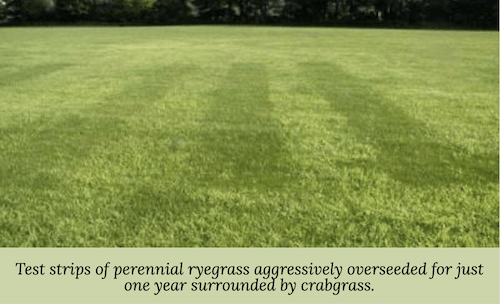
Cornell’s College of Agriculture and Life Sciences published an article on Overseeding, explaining sports field management with grass seed. In this article, Frank Rossi and Carl Schimenti take a deep dive at the benefits of an aggressive overseeding schedule. Let’s look at their recommendations and see how it can best fit into your maintenance schedule and budget. Cornell’s research was a 2#/1000SF weekly broadcast overseed with the three main cool season turf grasses (Turf type tall fescue, perennial rye, and Kentucky bluegrass). They simulated a 13 week season.
High Use Fields
“A widely accepted concept is that 25 events on a native soil football field is the limit for optimum turfgrass recovery. The grass cannot recuperate quickly enough when used for games, practices, gym class and other school activities. So overseeding must be done on a routine basis on high-use fields if there is any chance of providing a dense, more uniform, and safe playing surface.”
When working with athletic field managers or parks and rec staff, we often get a laugh out of how heavily used fields are. Considering 25 events as the upper metric for turfgrass recovery, it shows how vital overseeding is in providing a dense turf stand. The most common goal for sports surfaces is that they are SAFE. To provide a uniform playing surface you have to overseed frequently.
Ideal Overseeding Time
“An excellent time to overseed is right after aerating or cultivating your field”
August is the prime time to aerate and overseed your fields. Before athletes get back for preseason, you have a chance to core aerate which will improve compaction conditions via water infiltration and air movement. You also get the chance to overseed without disturbance or wear from athletes on germinating seedlings. The goal during any rest time is to establish a healthy ‘seed bank’ in the soil. Accordingly, you are aiming to give yourself the highest volume of turf grass before they go under heavy use.
Seed Varieties
“Research at Cornell and other universities found that overseeding weekly under high traffic conditions with either perennial ryegrass or tall fescue provided excellent season-long turf density. Perennial ryegrass was able to maintain almost 90% density and the tall fescue plots had between 70% and 80% density at the end of the study.
Note: Overseeding with Kentucky bluegrass (KBG) proved completely ineffective under regular traffic most likely due to the long germination and establishment requirement. The non-overseeded plots were less than 50% covered with turf and in some cases up to 20% weeds. Routine overseeding provided a dense, more uniform, safe playing surface.”
The statistics Cornell found were very significant in terms of preserving turf grass density with frequent overseeding. Look first at the non-overseeded plots. Less than 50% of the surface remained turf grass and, as we know, weeds will establish in the thin areas – up to 20%! Basic math on their findings suggests almost 30% of the surface was bare without overseeding. Conversely, the field frequently seeded with perennial rye resulted in 90% turf coverage by the end of the season.
Grass Seed Expense
“Worth the investment! Some budgets are large enough to pay for overseeding the entire field periodically. If having better coverage and less weed pressure are your goals then the benefits of an aggressive overseeding program will outweigh the cost.
But what if you had limited resources? You could concentrate your overseeding program in the areas that receive the most traffic (goal mouths, or between the hash marks and 20 yard lines) to reduce the cost.”
Recent spikes in grass seed prices have made it easy for managers to drop out of their programs but I’m here to reiterate Rossi and Schimenti’s notion that it is worth the investment! PJC Organic preaches species diversity and understands that overseeding is an accretive cultural practice. Every time you apply seed you introduce the surface that athletes should be playing on. Conversely, every time you skip seeding you provide weeds the opportunity to establish in the thin areas.
How frequently you overseed depends on budget and labor resources, but should never be removed from your program. When working with tighter budgets, I often recommend “in-season” overseeds to be between the hashes to reduce cost and increase turf coverage in high traffic areas. After spring season and before fall season – I recommend performing an aeration and overseed on the entire field when the grass has time to establish. Therefore giving you high density before athletes thin the surface out with use.
Breakdown of Grass Seed Applications
Here’s a quick table to reference a multi-use athletic field that sees Lacrosse and Soccer in the Spring and Football and Soccer use in the Fall. Spring and Fall overseeds are “Between the Hashes”.
| Field SQ. FT | Seed Variety | Season | Overseed Rate | Cost/LB | Cost/Application | Cost/Season |
| 20,000* | Tri-Rye
100 |
Spring | 6#/1000SF | $2.80 | $336.00 |
$2,887.20 |
| 60,000 | TTTF/KB/RYE
70/20/10 |
Early Summer | 5#/1000SF | $3.40 | $1,020.00 | |
| 60,000 | TTTF/KB/RYE
70/20/10 |
Late Summer | 5#/1000SF | $3.40 | $1,020.00 | |
| 20,000* | KB/RYE 50/50 | Fall | 6#/1000SF | $4.26 | $511.20 |
*Measurement is “Between the Hashes”
In this model, you’re getting 22# of grass seed per growing season in the high traffic areas for a modest price. These prices are representative of premium grass seed blends with cultivars hand selected from NTEP standards to be the best performing varieties for athletic settings.
View our Product Page, or contact us, for grass seed varieties and pricing. Set your fields apart with safe, high performance playing surfaces.
